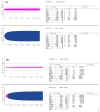Clinical Significance of Rotational Thromboelastometry (ROTEM) for Detection of Early Coagulopathy in Trauma Patients: A Retrospective Study
- PMID: 40361963
- PMCID: PMC12071595
- DOI: 10.3390/diagnostics15091148
Clinical Significance of Rotational Thromboelastometry (ROTEM) for Detection of Early Coagulopathy in Trauma Patients: A Retrospective Study
Abstract
Background: We aimed to evaluate the clinical significance of abnormal rotational thromboelastometry (ROTEM) findings in trauma patients and investigate the relationships between FIBTEM-maximum clot firmness (MCF), fibrinogen concentration and patient outcomes. Methods: A retrospective cohort analysis was conducted on adult trauma patients who underwent on-admission ROTEM testing between January 2020 and January 2021. Univariate analyses compared data based on injury severity, ROTEM findings (normal vs. abnormal), and initial fibrinogen concentration (normal vs. hypofibrinogenemia). ROC curve analysis was performed to determine the diagnostic performance of FIBTEM A10/MCF for its association with hypofibrinogenemia. Results: A total of 1488 patients were included in this study; the mean age was 36.4 ± 14.2 years and 92% were male. In total, 376 (25.3%) patients had ROTEM abnormalities. Severe injuries (ISS ≥ 16) were associated with a higher shock index, positive troponin T levels, standard coagulation abnormalities, hypofibrinogenemia, and abnormal ROTEM parameters (p < 0.05). These patients also had higher rates of massive transfusions and in-hospital mortality (p = 0.001). Coagulation alterations were significantly associated with higher injury severity score (ISS), shock index, head abbreviated injury score (AIS), hypofibrinogenemia, transfusion need, and mortality (p < 0.05). Hypofibrinogenemic patients were younger, sustained severe injuries, had higher shock indices and coagulation marker levels, required more intensive treatments, had longer hospital stays, and had higher mortality (p < 0.05). A significant positive correlation was found between plasma fibrinogen concentration and FIBTEM-MCF (r = 0.294; p = 0.001). Conclusions: Approximately one-fourth of the patients had early traumatic coagulopathy, as assessed by ROTEM. The FIBTEM A10/MCF may serves as a surrogate marker for plasma fibrinogen concentration. While prior studies have established the link between ROTEM and injury severity, our findings reinforce its relevance across varying trauma severity levels. However, prospective studies are warranted to validate its role within diverse trauma systems and evolving resuscitation protocols.
Keywords: ROTEM; coagulation abnormalities; outcomes; polytrauma; severity of injury.
Conflict of interest statement
The authors declare no conflicts of interest.
Figures



References
LinkOut - more resources
Full Text Sources

